Visfatin (NAMPT) Human ELISA
Visfatin, also known as pre-B-cell colony-enhancing factor and Nicotinamide Phosphoribosyltransferase (Nampt) is a polypeptide of 491 amino acids with a molecular mass of 52 kDa. It has recently been identified as a novel adipokine expressed in adipocytes and secreted from adipose tissue, especially from visceral fat. Visfatin was also found to be expressed in other tissues including leukocytes, skeletal muscle, liver and kidney. The expression of visfatin is upregulated in a glucose-dependent manner and is increased by an intravenous glucose tolerance test.
Visfatin was also found to act as a key enzyme in the process of nicotinamide adenine dinucleotide biosynthetic activity, which could play a major role in maintaining β-cell function in obese subjects and those with type 2 diabetes mellitus. Incubation with visfatin in clonal mouse pancreatic β cells increased insulin upregulation by ninefold and caused a 46% increase in insulin secretion as compared with a low glucose environment. In addition, acute injections of visfatin into KKAy mice in an obese type 2 diabetic model significantly reduced plasma glucose. One study reported that acute administration of visfatin was able to prevent cardiomyocyte death at the onset of myocardial reperfusion while other reports have suggested that chronic visfatin expression exerts an atherogenic effect. Chronic treatment with visfatin may induce leukocyte adhesion to endothelial cells and the aortic endothelium by induction of the cell adhesion molecules ICAM-1 and VCAM-1, suggesting that visfatin is a vascular inflammatory mediator. In addition, other studies have shown high levels of visfatin in atherogenic plaques obtained from patients with acute myocardial infarction. Visfatin can activate matrixmetalloproteinase 2/9 expression in human endothelial cells, implying a pathway of atherogenic plaque instability. Visfatin has been also shown to elicit pro-inflammatory signals in human aortic smooth muscle cells. These reports suggest a complex interaction between visfatin and inflammatory atherosclerotic diseases. Plasma visfatin has been reported to be elevated in patients with type 2 diabetes mellitus, overweight/obesity problems and in subjects with metabolic syndrome. Furthermore, circulating visfatin levels were found to be positively associated with insulin resistance, and is elevated in patients with cardiovascular diseases.
Human Visfatin ELISA is to be used for the in vitro quantitative determination of human visfatin in serum.
This assay is a sandwich Enzyme Linked-Immunosorbent Assay (ELISA) for quantitative determination of human Nampt in biological fluids. A monoclonal antibody specific for Nampt has been precoated onto the 96-well microtiter plate. Standards and samples are pipetted into the wells for binding to the coated antibody. After extensive washing to remove unbound compounds, Nampt is recognized by the addition of a purified polyclonal antibody specific for Nampt (Detection Antibody). After removal of excess polyclonal antibody, HRP conjugated anti-rabbit IgG (Detector) is added. Following a final washing, peroxidase activity is quantified using the substrate 3,3’,5,5’-tetramethylbenzidine (TMB). The intensity of the color reaction is measured at 450 nm after acidification and is directly proportional to the concentration of Nampt in the samples.
Intended use
Clinical Application
Test principle
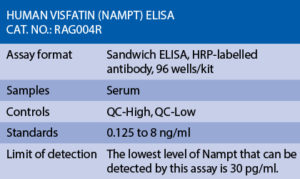
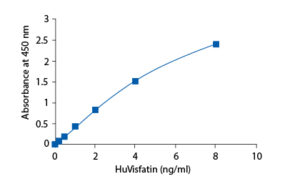
Precision
Intra-assay (Within-Run) (n=4) Four samples of known concentrations of human Nampt were assayed in replicates 4 times to test precision within an assay.
Intra-assay (Within-Run) (n=7) Four samples of known concentrations of human Nampt were assayed in 7 separate assays to test precision between assays.
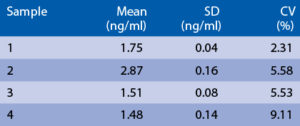
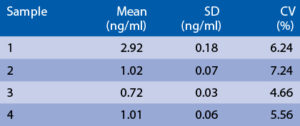
When samples (serum) are spiked with known concentrations of human Nampt, the recovery averages 98% (range from 90% to 110%). Different human serum samples containing Nampt were diluted several fold (1 to 1/4) and the measured recoveries ranged from 85% to 105%.
Spiking recovery
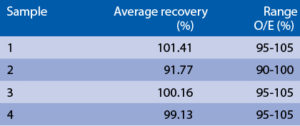
Linearity
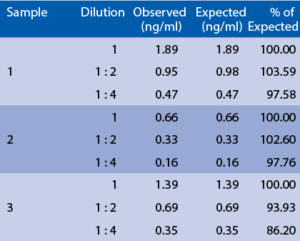
Summary of protocol
– Karpavicius A, ORCID: http://orcid.org/0000-0002-0656-7943, Dambrauskas Z, Gradauskas A, Samuilis A, Zviniene K, Kupcinskas J, Brimas G, Meckovski A, Sileikis A, Strupas K. The clinical value of adipokines in predicting the severity and outcome of acute pancreatitis. BMC Gastroenterol. 2016;16 (1):99
– Meier FM, Frommer KW, Peters MA, Brentano F, Lefevre S, Schroder D, Kyburz D, Steinmeyer J, Rehart S, Gay S, Muller-Ladner U, Neumann E. Visfatin/pre-B-cell colony-enhancing factor (PBEF), a proinflammatory and cell motility-changing factor in rheumatoid arthritis. J Biol Chem. 2012 Aug 17;287 (34):28378-85
– Samsam-Shariat SZ, Bolhasani M, Sarrafzadegan N, Najafi S, Asgary S. Relationship between blood peroxidases activity and visfatin levels in metabolic syndrome patients. ARYA Atheroscler. 2014 Jul;10 (4):218-26
– Seo DI, So WY, Ha S, Yoo EJ, Kim D, Singh H, Fahs CA, Rossow L, Bemben DA, Bemben MG, Kim E. Effects of 12 weeks of combined exercise training on visfatin and metabolic syndrome factors in obese middle-aged women. J Sports Sci Med. 2011;10 (1):222-6
– Wojcik K, Jablonowska E, Omulecka A, Piekarska A. Insulin resistance, adipokine profile and hepatic expression of SOCS-3 gene in chronic hepatitis C. World J Gastroenterol. 2014 Aug 14;20 (30):10449-56

